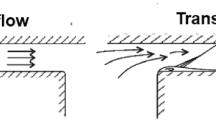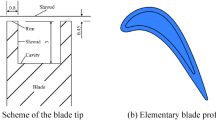Abstract
For unshrouded blade tip, the high-temperature gas flows through the tip clearance by force of the lateral pressure difference. Thereby, the blade tip endures increasing thermal load. Furthermore, the conventional blade tip treatment cannot continuously provide protection for the deteriorating service environment. In the present study, aerothermal characteristics of the squealer blade tip with staggered ribs, partial squealer rim and different partial squealer rim thickness were investigated to explore the influences of ribbed-cavity tip on the tip heat transfer, leakage flow and turbine stage efficiency. The numerical results indicate that the ribbed-cavity tips are beneficial for the reduction of the blade tip thermal load and leakage flow. Among the present six blade tip designs, the minimal area-averaged heat transfer coefficient is obtained by the case with the staggered ribs and a deeper squealer rim, which is reduced by 31.41% relative to the squealer tip. Plus, the blade tip modification closer to leading edge or tip mid-chord region performs better than trailing edge in reducing the tip leakage flow.
Similar content being viewed by others
Abbreviations
- A :
-
area
- A i :
-
area of the dividing surface numbered i
- c p :
-
specific heat at constant pressure
- d :
-
depth of the squealer rim
- h :
-
heat transfer coefficient
- \(\overline{\overline{h}}\) :
-
area-averaged heat transfer coefficient
- \(\overline{\overline{h_{i}}}\) :
-
area-averaged heat transfer coefficient of the dividing surface numbered i
- M :
-
torque
- m :
-
mass flow rate
- n :
-
total amount of the dividing surfaces on blade tip
- p * :
-
total pressure
- q :
-
wall heat flux
- s :
-
blade tip clearance height
- T :
-
temperature
- T * :
-
absolute total temperature
- T w :
-
wall temperature
- T ∞ :
-
mainstream temperature
- v :
-
velocity
- w :
-
width of the squealer rim
- y + :
-
dimensionless wall-normal height of first cell at wall
- η :
-
turbine stage efficiency
- ρ :
-
density
- ω :
-
angular velocity
- in:
-
inlet of computational domain
- leak:
-
leakage
- nor:
-
normal
- out:
-
outlet of computational domain
- w:
-
wall condition
- ∞:
-
mainstream conditions
References
Sunden B., **e G.N., Gas turbine blade tip heat transfer and cooling: a literature survey. Heat Transfer Engineering, 2010, 31: 527–554.
Denton J.D., Loss mechanisms in turbomachines. ASME Journal of Turbomachinery, 1993, 115: 621–656.
Bunker R.S., A review of turbine blade tip heat transfer. Annals of the New York Academy of Sciences, 2001, 934: 64–79.
Bunker R.S., Axial turbine blade tips: function, design, and durability. AIAA Journal of Propulsion and Power, 2012, 22: 271–285.
Han J.C., Fundamental gas turbine heat transfer. Journal of Thermal Science and Engineering Applications, 2013, 5(2): 021007.
Lee S.W., Moon H.S., Lee S.E., Tip gap height effects on flow structure and heat/mass transfer over plane tip of a high-turning turbine rotor blade. International Journal of Heat and Fluid Flow, 2009, 30(2): 198–210.
Bindon J.P., The measurement and formation of tip clearance loss. Journal of Turbomachinery, 1989, 3(111): 257–263.
Kwak J.S., Han J.C., Heat-transfer coefficients of a turbine blade-tip and near-tip regions. Journal of Thermophysics and Heat Transfer, 2003, 17(3): 297–303.
Gao J., Fu W., Wang F., Experimental and numerical investigations of tip clearance flow and loss in a variable geometry turbine cascade. Proceedings of the Institution of Mechanical Engineers, Part A: Journal of Power and Energy, 2018, 232(2): 157–169.
Kwak J.S., Han J.C., Heat transfer coefficients on the squealer tip and near squealer tip regions of a gas turbine blade. Journal of Heat Transfer, 2003, 125(4): 669–677.
Lee S.W., Kim S.U., Tip gap height effects on the aerodynamic performance of a cavity squealer tip in a turbine cascade in comparison with plane tip results: Part 1—tip gap flow structure. Experiments in Fluids, 2010, 49(5): 1039–1051.
Lee S.W., Choi M.Y., Tip gap height effects on the aerodynamic performance of a cavity squealer tip in a turbine cascade in comparison with plane tip results: Part 2—aerodynamic losses. Experiments in Fluids, 2010, 49(3): 713–723.
Maral H., Senel C.B., Kavurmacioglu L., A parametric and computational aerothermal investigation of squealer tip geometry in an axial turbine: a parametric approach suitable for future advanced tip carving optimizations. Turbo Expo: Power for Land, Sea, and Air, 2016, Paper No. GT2016-58107.
Maral H., Senel C.B., Deveci K., et al., A genetic algorithm based multi-objective optimization of squealer tip geometry in axial flow turbines: a constant tip gap approach. Journal of Fluids Engineering, 2020, 142(2): 021402.
** J., Song Y., Yu J., et al., Effect of arbitrary blade tip design on tip leakage flow. Proceedings of the Institution of Mechanical Engineers, Part A: Journal of Power and Energy, 2020, 234(1): 19–30.
Huang T., Li H., Yuan X., et al., Influences of depth and rim width of squealer tip on the leakage flow and heat transfer. Global Power and Propulsion Society, 2021. DOI: https://doi.org/10.33737/gpps21-tc-181.
Nasir H., Ekkad S.V., Kontrovitz D.M., Effect of tip gap and squealer geometry on measured heat transfer over a HPT rotor blade tip. ASME International Mechanical Engineering Congress and Exposition, 2003, Paper No. IMECE2003-41294.
Kwak J.S., Ahn J., Han J.C., et al., Heat transfer coefficients on the squealer tip and near-tip regions of a gas turbine blade with single or double squealer. Journal of Turbomachinery, 2003, 125(4): 778–787.
Ledezma G.A., Allen J., Bunker R.S., An experimental and numerical investigation into the effects of squealer blade tip modifications on aerodynamic performance. ASME Turbine Blade Tip Symposium, 2013, Paper No. TBTS2013-2004.
Krishnababu S.K., Newton P.J., Dawes W.N., Aerothermal investigations of tip leakage flow in axial flow turbines-part I: effect of tip geometry and tip clearance gap. Journal of turbomachinery, 2009, 131(1): 55–68.
Ma H., Tian Y., Numerical investigation of effects of non-uniform tip clearance on flow field inside a turbine cascade. ASME International Mechanical Engineering Congress and Exposition, 2016, Paper No. IMECE2016-66509.
Park J.S., Lee S.H., Lee W.S., et al., Heat transfer and secondary flow with a multi-cavity gas turbine blade tip. Journal of Thermophysics and Heat Transfer, 2016, 30(1): 120–129.
Kaczyński P., Szwaba R., Wasilczuk F., Leakage flow reduction in different configuration of labyrinth seal on a turbine blade tip. Journal of Physics: Conference Series, 2018, 1101(1): 012012.
Du K., Li Z., Li J., et al., Influences of a multi-cavity tip on the blade tip and the over tip casing aerothermal performance in a high pressure turbine cascade. Applied Thermal Engineering, 2019, 147: 347–360.
Tong F., Gou W., Li L., et al., Numerical investigation of high pressure turbine blade tip-sha** effects on the aerothermal a dynamic performance. Multidiscipline Modeling in Materials and Structures, 2019, 6(15): 1121–1135.
Zou Z., Shao F., Li Y., et al., Dominant flow structure in the squealer tip gap and its impact on turbine aerodynamic performance. Energy, 2017, 138: 167–184.
Zou Z., Xuan L., Chen Y., et al., Effects of flow structure on heat transfer of squealer tip in a turbine rotor blade. International Communications in Heat and Mass Transfer, 2020, 114: 10458.
Zeng F., Zhang W., Wang Y., et al., Effects of squealer geometry of turbine blade tip on the tip-leakage flow and loss. Journal of Thermal Science, 2021, 30(4): 1376–1387.
Jiang S., Yu J., Wang H., et al., Experimental investigation of the bending clearance on the aerodynamic performance in turbine blade tip region. Energy, 2020, 197: 117234.
Kim J., Seo W., Chung H., et al., Effect of shelf squealer tip configuration on aerothermal performance of gas turbine blade. International Journal of Thermal Sciences, 2021, 168: 107056.
Acknowledgement
The authors gratefully acknowledge the support of National Natural Science Foundation of China (No. 52006178, 51936008), National Key R&D Program of China (No. Y2019-VIII-0007-0168) and the Fundamental Research Funds for the Central Universities and the Innovation Capacity Support Plan in Shaanxi Province of China (Grant No. 2023-CX-TD-19).
Author information
Authors and Affiliations
Corresponding author
Rights and permissions
About this article
Cite this article
Du, K., Li, H., Sunden, B. et al. Effects of Ribbed-Cavity Tip on the Blade Tip Aerothermal Performance in a High Pressure Turbine Stage. J. Therm. Sci. 32, 800–811 (2023). https://doi.org/10.1007/s11630-023-1771-5
Received:
Published:
Issue Date:
DOI: https://doi.org/10.1007/s11630-023-1771-5




